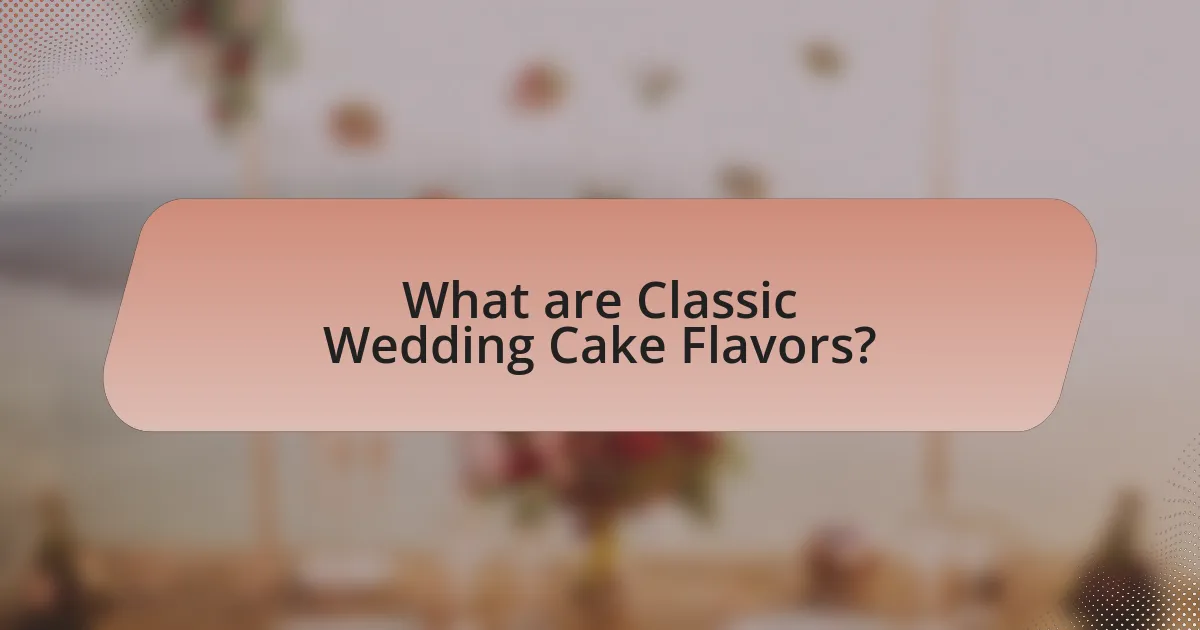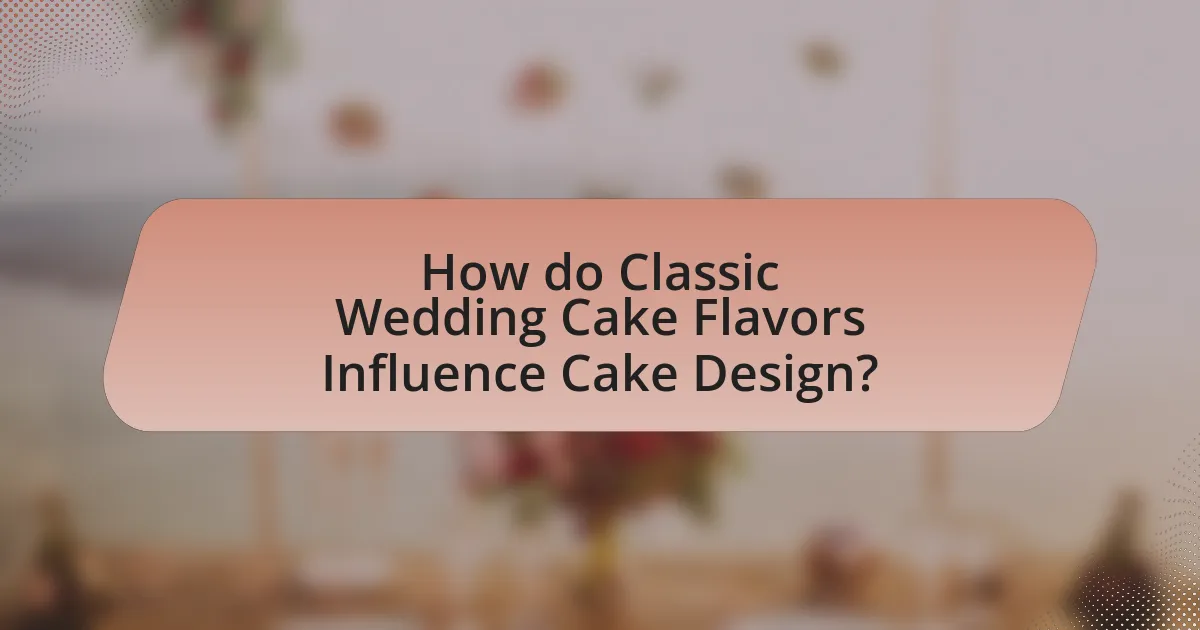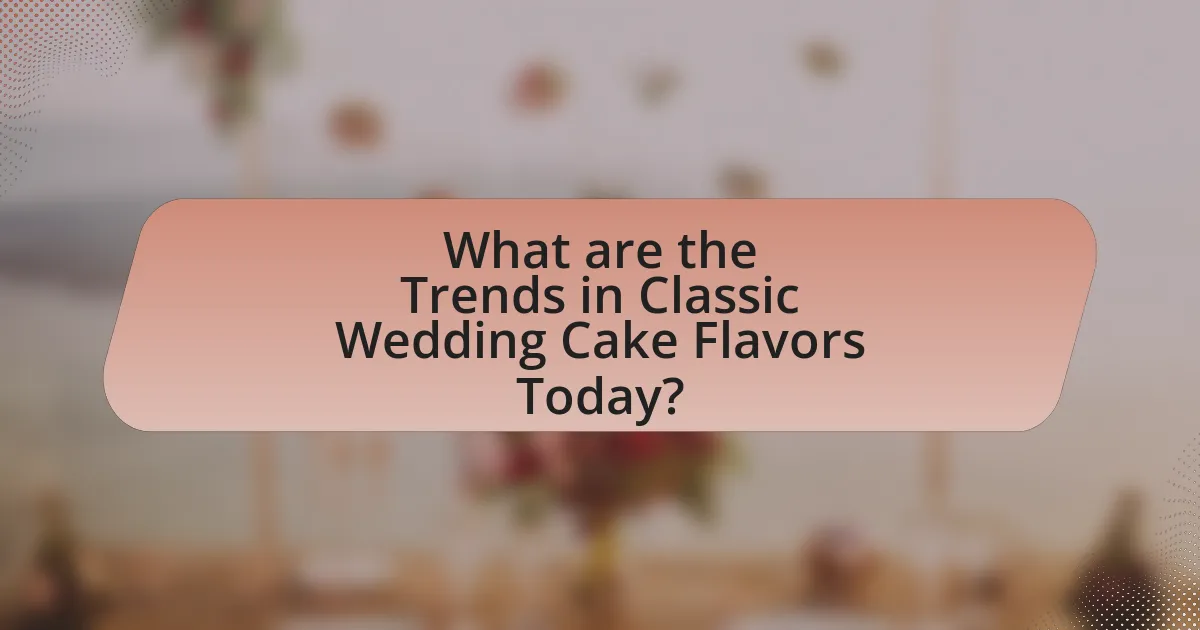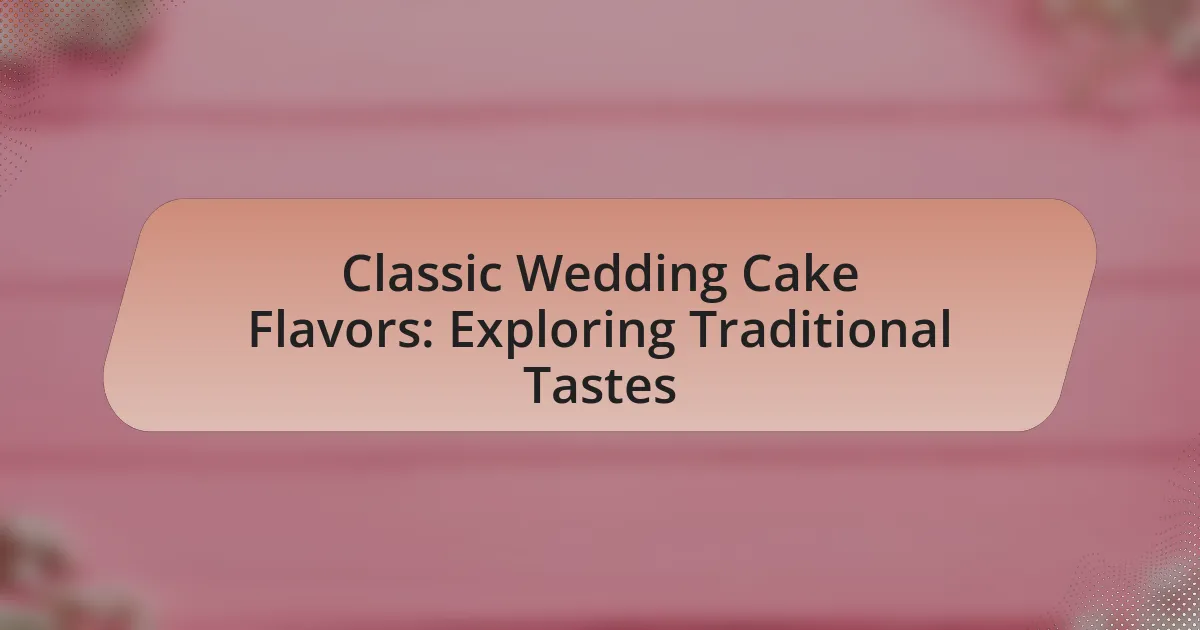Classic wedding cake flavors, including vanilla, chocolate, and lemon, are celebrated for their broad appeal and cultural significance. These traditional flavors evoke nostalgia and symbolize the union of families, often reflecting personal tastes and preferences. The article explores the importance of these flavors in wedding cakes, their historical roots, and how they influence cake design and presentation. Additionally, it discusses current trends, innovative twists on classic flavors, and best practices for flavor pairing, providing couples with insights on selecting the perfect cake for their special day.

What are Classic Wedding Cake Flavors?
Classic wedding cake flavors include vanilla, chocolate, and lemon. These flavors have been traditionally favored for their broad appeal and versatility. Vanilla is often chosen for its classic taste and ability to pair well with various fillings and frostings. Chocolate offers a rich, indulgent option that is popular among guests. Lemon provides a refreshing alternative, especially for spring and summer weddings. These flavors are commonly used in wedding cakes due to their historical significance and consistent popularity in celebratory events.
Why are traditional flavors important in wedding cakes?
Traditional flavors are important in wedding cakes because they symbolize cultural heritage and evoke nostalgia among guests. These flavors, such as vanilla, chocolate, and almond, have been passed down through generations, creating a sense of familiarity and comfort during a significant life event. Additionally, studies show that familiar tastes can enhance emotional connections, making the wedding experience more memorable for couples and their families.
What cultural significance do these flavors hold?
Classic wedding cake flavors hold significant cultural importance as they often symbolize tradition, celebration, and the union of families. For instance, flavors like vanilla, chocolate, and fruitcake have historical roots in various cultures, representing prosperity and fertility. In many Western cultures, the choice of flavor can reflect regional preferences and family heritage, reinforcing social bonds during the wedding ceremony. Additionally, specific flavors may be tied to rituals or customs, such as the use of fruitcake in British weddings, which is believed to bring good luck. These flavors not only enhance the sensory experience of the celebration but also serve as a means of honoring cultural legacies and familial connections.
How do classic flavors reflect personal tastes and preferences?
Classic flavors reflect personal tastes and preferences by embodying cultural significance and individual nostalgia. For instance, flavors like vanilla, chocolate, and almond are often chosen for wedding cakes because they evoke familiarity and comfort, aligning with traditional expectations. Research indicates that flavor preferences are influenced by early experiences and cultural backgrounds, which shape an individual’s palate. This connection to classic flavors allows couples to express their identities and shared histories through their cake choices, reinforcing the emotional significance of the event.
What are the most popular classic wedding cake flavors?
The most popular classic wedding cake flavors are vanilla, chocolate, and red velvet. Vanilla is favored for its versatility and ability to pair well with various fillings and frostings. Chocolate is a timeless choice, often appreciated for its rich taste and indulgence. Red velvet, characterized by its unique color and subtle cocoa flavor, has gained popularity for its visual appeal and distinct taste. These flavors have remained staples in wedding cake selections due to their widespread appeal and tradition in celebratory events.
What distinguishes vanilla as a classic flavor?
Vanilla is distinguished as a classic flavor due to its universally appealing taste and versatility in culinary applications. This flavor profile is characterized by its sweet, creamy notes, which complement a wide range of ingredients, making it a staple in desserts and baked goods. Historically, vanilla has been used since the 16th century, originating from Mexico, and has since become a fundamental flavor in various cuisines worldwide. Its popularity is further supported by the fact that vanilla is the second most expensive spice after saffron, highlighting its value and significance in flavoring.
How does chocolate remain a timeless choice?
Chocolate remains a timeless choice due to its rich flavor, versatility, and cultural significance. Its deep, complex taste appeals to a wide range of palates, making it a preferred ingredient in various desserts, including wedding cakes. Historically, chocolate has been celebrated since ancient civilizations, such as the Aztecs and Mayans, who valued it for its unique properties and used it in ceremonial contexts. This longstanding appreciation contributes to its enduring popularity in modern celebrations, particularly weddings, where chocolate flavors are often favored for their indulgence and familiarity.
What makes red velvet a favorite among couples?
Red velvet is a favorite among couples primarily due to its visually striking appearance and unique flavor profile. The cake’s rich red color symbolizes love and passion, making it an ideal choice for romantic occasions like weddings. Additionally, the combination of cocoa and buttermilk creates a subtle chocolate flavor that pairs well with cream cheese frosting, enhancing its appeal. According to a survey by The Knot, red velvet consistently ranks among the top cake flavors chosen by couples for weddings, reflecting its popularity and emotional significance in celebratory contexts.

How do Classic Wedding Cake Flavors Influence Cake Design?
Classic wedding cake flavors significantly influence cake design by dictating the overall aesthetic and thematic elements of the cake. For instance, traditional flavors like vanilla, chocolate, and lemon often lead to designs that reflect classic elegance, utilizing smooth fondant or buttercream finishes and simple, timeless decorations such as fresh flowers or delicate piping. Additionally, flavors like red velvet or carrot cake may inspire bolder color choices and textures, prompting designs that incorporate rich hues or rustic elements. The choice of flavor not only affects the visual presentation but also aligns with the couple’s personal tastes and the wedding’s overall theme, ensuring that the cake complements the event’s atmosphere.
What role do flavors play in the overall cake presentation?
Flavors are essential in cake presentation as they significantly influence the overall sensory experience and perception of the cake. A well-chosen flavor enhances the visual appeal by complementing the cake’s design and decorations, creating a cohesive theme that resonates with the occasion, such as weddings. For instance, traditional flavors like vanilla, chocolate, and almond are often associated with weddings, providing a familiar and comforting taste that aligns with the celebratory atmosphere. Research indicates that flavor perception is closely linked to visual cues; thus, a cake that looks appealing and tastes delightful can leave a lasting impression on guests, reinforcing the significance of the event.
How can flavor choices affect frosting and decoration styles?
Flavor choices significantly influence frosting and decoration styles by dictating the type of ingredients and colors used. For instance, a vanilla-flavored cake often pairs with buttercream frosting, which can be easily tinted to match a wedding’s color scheme, while a chocolate cake may be complemented by ganache, leading to a more elegant, darker aesthetic. Additionally, unique flavors like lemon or almond can inspire creative decorations, such as citrus-themed designs or floral accents that reflect the cake’s taste profile. This relationship between flavor and decoration is supported by industry practices where flavor profiles guide the visual presentation, ensuring that the overall design aligns with the cake’s taste, enhancing the guest experience.
What are some design trends associated with classic flavors?
Design trends associated with classic flavors in wedding cakes include the use of vintage aesthetics, elegant color palettes, and intricate detailing. Vintage aesthetics often feature lace, floral motifs, and tiered designs that evoke a sense of nostalgia, aligning with traditional flavors like vanilla, chocolate, and red velvet. Elegant color palettes, such as soft pastels or monochromatic schemes, complement these classic flavors, enhancing the overall visual appeal. Intricate detailing, including hand-piped decorations and sugar flowers, adds sophistication and reflects the craftsmanship associated with timeless cake recipes. These trends not only celebrate classic flavors but also elevate the presentation of wedding cakes, making them focal points at celebrations.
How can couples choose the right flavor for their wedding cake?
Couples can choose the right flavor for their wedding cake by considering their personal preferences, guest tastes, and seasonal ingredients. Personal preferences should reflect the couple’s favorite flavors, while guest tastes can be gauged through surveys or discussions with family and friends to ensure a wider appeal. Seasonal ingredients can enhance flavor and freshness; for example, using berries in summer or spices in fall can create a more relevant and enjoyable cake. Additionally, tasting sessions with bakers can provide insight into flavor combinations and textures, helping couples make an informed decision.
What factors should be considered when selecting a flavor?
When selecting a flavor for a classic wedding cake, key factors include the preferences of the couple, seasonal availability of ingredients, and the overall theme of the wedding. Couples should prioritize their personal tastes, as the cake is often a centerpiece of the celebration. Seasonal ingredients can enhance flavor and freshness; for example, using berries in summer or spices in fall can align with the season. Additionally, the cake flavor should complement the wedding theme, whether it be traditional, modern, or cultural, ensuring a cohesive experience for guests.
How can taste testing help in the decision-making process?
Taste testing aids in the decision-making process by providing direct sensory feedback on flavor preferences, which is crucial for selecting wedding cake flavors. This method allows individuals to evaluate the taste, texture, and overall appeal of various cake options, ensuring that the final choice aligns with personal and guest preferences. Research indicates that sensory evaluation significantly influences consumer choices, as it engages multiple senses and creates a more informed decision-making environment. By incorporating taste testing, couples can confidently choose flavors that resonate with their vision for the wedding, ultimately enhancing guest satisfaction and the overall experience.

What are the Trends in Classic Wedding Cake Flavors Today?
Current trends in classic wedding cake flavors include a resurgence of traditional tastes such as vanilla, chocolate, and red velvet, often enhanced with modern twists like salted caramel or citrus infusions. According to a survey by The Knot in 2022, 30% of couples chose vanilla as their primary flavor, while chocolate and red velvet followed closely, indicating a preference for familiar, comforting options. Additionally, the incorporation of unique fillings and frostings, such as cream cheese or fruit preserves, is becoming increasingly popular, allowing couples to personalize their cakes while still honoring classic flavors.
How have classic flavors evolved in modern weddings?
Classic flavors in modern weddings have evolved to incorporate diverse culinary influences and innovative techniques. Traditionally, wedding cakes featured flavors like vanilla, chocolate, and fruit, but contemporary trends now embrace unique combinations such as lavender, matcha, and salted caramel. This shift reflects a broader cultural movement towards personalization and gourmet experiences, with couples seeking to express their individuality through flavor choices. Additionally, the rise of dietary considerations, such as gluten-free and vegan options, has further diversified the flavor landscape, allowing for a wider range of tastes that cater to various preferences and restrictions.
What innovative twists are being added to traditional flavors?
Innovative twists being added to traditional flavors include the incorporation of unique ingredients and modern techniques that enhance classic profiles. For example, bakers are infusing traditional vanilla cake with flavors like lavender or matcha, creating a fusion of familiar and contemporary tastes. Additionally, the use of alternative sweeteners, such as honey or agave, is becoming popular, offering a healthier twist on classic recipes. These innovations not only appeal to evolving consumer preferences but also reflect a growing trend towards personalization in wedding cakes, allowing couples to express their individuality while honoring tradition.
How do dietary restrictions influence flavor choices?
Dietary restrictions significantly influence flavor choices by limiting the ingredients available for use in food preparation. For instance, individuals with gluten intolerance must avoid wheat-based products, leading to the selection of alternative flours like almond or coconut flour, which impart different flavors to baked goods. Additionally, those following vegan diets eliminate animal products, prompting the use of plant-based substitutes such as aquafaba or nut milks, which can alter the flavor profile of traditional recipes. Research indicates that 30% of consumers consider dietary restrictions when selecting flavors, highlighting the impact of health considerations on culinary preferences.
What are some tips for incorporating classic flavors into a wedding cake?
To incorporate classic flavors into a wedding cake, choose traditional options such as vanilla, chocolate, and almond, as these flavors are widely recognized and loved. Vanilla can be enhanced with real vanilla beans or extract for depth, while chocolate can be made richer with dark chocolate or cocoa powder. Almond flavoring adds a unique twist that complements other flavors well. Additionally, consider layering these flavors; for instance, a vanilla cake with chocolate ganache or almond buttercream can create a sophisticated taste profile. Classic flavor combinations, such as lemon and raspberry or red velvet with cream cheese frosting, also provide a timeless appeal. These choices are supported by the popularity of these flavors in wedding cakes, as they have been staples in traditional baking for decades.
How can couples balance tradition with personal flair?
Couples can balance tradition with personal flair by incorporating unique elements into classic wedding cake designs while maintaining traditional flavors. For example, they can choose a traditional vanilla or chocolate cake base but personalize it with custom decorations, such as monograms or themed cake toppers that reflect their relationship. This approach allows couples to honor classic tastes while expressing their individuality, as evidenced by a survey from The Knot, which found that 60% of couples opt for a traditional flavor but add personal touches to their cake design.
What are the best practices for flavor pairing in wedding cakes?
The best practices for flavor pairing in wedding cakes involve selecting complementary flavors that enhance the overall taste experience. Pair classic flavors like vanilla with fruity options such as raspberry or lemon to create a balanced profile. Additionally, incorporating contrasting textures, such as a rich chocolate cake with a light cream cheese frosting, can elevate the flavor combination. Research indicates that flavor pairing based on shared aromatic compounds can lead to more harmonious combinations, as seen in culinary studies that emphasize the importance of balancing sweetness with acidity.
